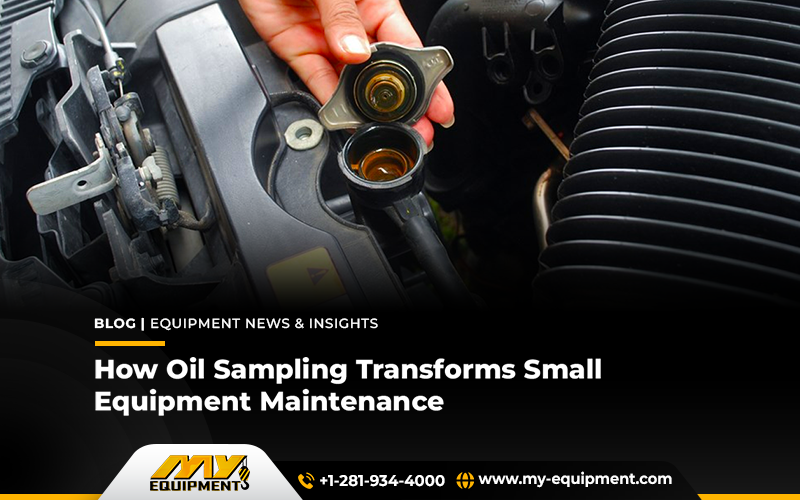Construction contractors or fleet managers often ignore the importance of oil sampling in the equipment. It is, however, a major part of equipment maintenance that must not be overlooked. The way of sampling the oil from the equipment decides a lot about the equipment’s efficiency and performance. People, sometimes, confused by the misconception that this practice benefits only the large fleet and not the small equipment owner. An industry expert, Shelly Eckert from Chevron, has unveiled the rumour and explained the best way to sample oil from the equipment, optimizing its efficiency and making better decisions.
How much does oil sampling cost?
First thing first. The oil sampling seems like an extra cost on the equipment maintenance which entirely depends on how it has been carried out. An average oil sampling and analysis can cost anything from $20 to $54 per sample. This variation frequently indicates how well the analysis was performed in the laboratory. Though the initial expense may put some people off, it’s important to look at the bigger picture. A better and more detailed analysis will help the owner know more about the equipment and its efficiency.
For smaller businesses, oil sampling could cost less than $500 per year if they have two or three pieces of equipment. The annual cost seldom goes over $1,500, not even for significantly bigger fleets. When you consider the possible savings from avoiding even one costly repair, this expense seems insignificant. For example, the cost of fixing an engine failure might range from $7,000 to $10,000, which is far more than the annual cost of an oil sampling.
How much do old vs modern oil sampling methods differ?
People have long been practicing the old oil sampling method in their equipment making some guesses and judgments randomly. This does not give them the whole picture of the equipment status. This practice might not be useful, especially for older equipment like a used track excavator.
Many equipment owners think that a regular oil change is enough to keep the equipment working in good condition. Whereas, a professional oil sampling and analysis provides a more accurate and practical outcome. For instance, finding metal shavings in an oil sample can reveal wear in its early stages, which, if ignored, could result in significant failures. Routine oil changes just cannot give this kind of preventative maintenance.
What other benefits does an oil analysis provide?
The ultimate benefit of oil sampling and analysis is its capacity to avoid expensive equipment malfunctions. There are more financial complications than just repair expenses when equipment malfunctions. In addition, there are losses from labour, replacement parts, and downtime, not to mention the possible logistical difficulties involved in moving the equipment for repairs. Therefore, oil analysis can ultimately save operators thousands of dollars by seeing any problems early.
On the other hand, oil sampling improves the equipment’s resale value in addition to assisting in the prevention of breakdowns. Additionally, a history of routine oil analysis can prove to prospective purchasers that the equipment has been well-maintained, thus increasing its value. It can also strengthen warranty claims by demonstrating careful maintenance procedures. One must consider practicing detailed oil sampling even if they have a small fleet. This may help in optimizing the equipment’s performance and efficiency.
How often should oil sampling be done?
Oil sampling analysis does not mean to do it regularly if no wear is found. A proper and professional analysis will be enough for a longer time. Shelly Eckert suggests sampling oil at each interval of draining. To make sure the issue is fixed, it could be required to resample and shorten the interval if an irregularity is found. This preventive measure helps keep the equipment in good working order by keeping impurities like dirt, gasoline dilution, and coolant contamination away.
Better late than never, it’s never too late to start caring for your old equipment. An oil sampling program can be advantageous even if the equipment is already a few years old. Labs can track wear trends and set baselines using industry data that is already available, giving them important information about the equipment’s state. Regular oil analysis can help older equipment run better and have longer lifespans, while younger machines benefit from early problem discovery.
Wrap Up
Oil sampling is an economical heavy machinery maintenance technique that may be used by small and big fleet operators alike. Owners of equipment can prolong equipment life, save expensive repairs, and raise resale value by making a minimal annual investment. Oil sampling is a hands-on strategy that turns maintenance from a reactive to a preventive action, guaranteeing that equipment runs effectively and economically. Including oil samples in routine maintenance is not only a wise financial move for small companies, but it also yields substantial benefits.


 1400 Broadfield Blvd, Houston, TX 77084,
USA.
1400 Broadfield Blvd, Houston, TX 77084,
USA. omer@my-equipment.com
omer@my-equipment.com